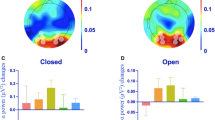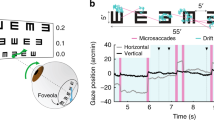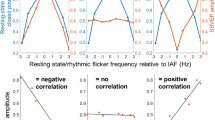Abstract
People can be taught to control voluntarily their own alpha rhythms. This can be used to send messages in Morse code when an electroencephalogram pattern is used as part of a computer programme. Such procedures may help to explain the mechanisms by which the alpha rhythm is “blocked” or “unblocked”.
This is a preview of subscription content, access via your institution
Access options
Subscribe to this journal
Receive 51 print issues and online access
$199.00 per year
only $3.90 per issue
Buy this article
- Purchase on Springer Link
- Instant access to full article PDF
Prices may be subject to local taxes which are calculated during checkout
Similar content being viewed by others
References
Adrian, E. D., Matthews, B. H. C., Brain, 57, 355 (1934) (see also Durup, G., and Fessard, Année Psychol., 36, 1 (1935)).
Penfield, W., and Jasper, H. H., Epilepsy and the Functional Anatomy of the Human Brain, 189 (Little, Brown, 1954).
Hill, J. D. N., and Parr, G., Electroencephalography, 238 (Macmillan, 1963).
Mundy-Castle, A. C., EEG Clin. Neurophysiol., 9, 643 (1957).
Fraisse, P., and Voillaume, C., EEG Clin. Neurophysiol., 13, 485 (1961).
Oswald, I., EEG Clin. Neurophysiol., 11, 601 (1959).
Mulholland, T., and Evans, C. R., Nature, 207, 36 (1965).
Mulholland, T., and Evans, C. R., Nature, 211, 1278 (1966).
Dewan, E. M., Air Force Cambridge Res. Labs., 64–910.
Dewan, E. M., Proc. Symp. on Biomed. Eng., 1, 349 (1966).
Author information
Authors and Affiliations
Rights and permissions
About this article
Cite this article
DEWAN, E. Occipital Alpha Rhythm Eye Position and Lens Accommodation. Nature 214, 975–977 (1967). https://doi.org/10.1038/214975a0
Published:
Issue Date:
DOI: https://doi.org/10.1038/214975a0
This article is cited by
-
EEG-based imagined words classification using Hilbert transform and deep networks
Multimedia Tools and Applications (2024)
-
Imagined word pairs recognition from non-invasive brain signals using Hilbert transform
International Journal of System Assurance Engineering and Management (2022)
-
Brain control and information transfer
Experimental Brain Research (2015)
Comments
By submitting a comment you agree to abide by our Terms and Community Guidelines. If you find something abusive or that does not comply with our terms or guidelines please flag it as inappropriate.



